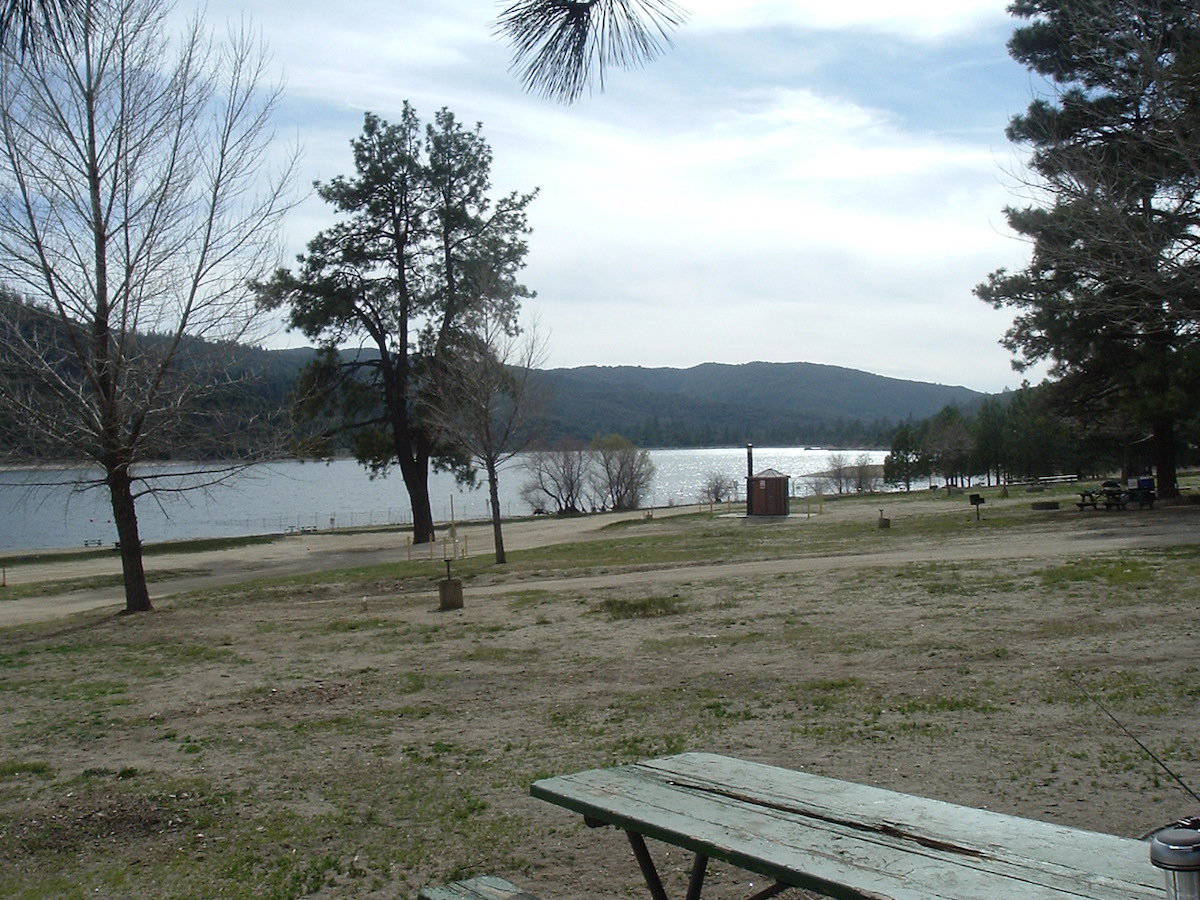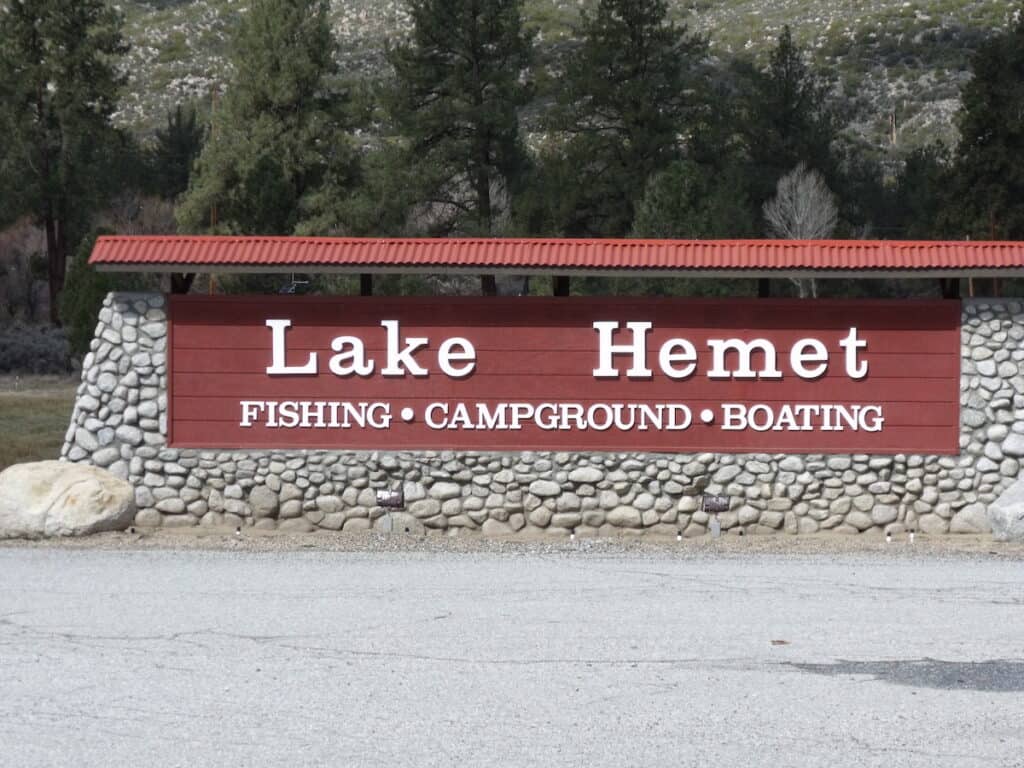Lake Hemet is best known as a trout-fishing destination in the San Jacinto Mountains of Southern California.
Angling at this 420-acre water storage reservoir can also be good for largemouth bass, panfish, catfish and carp.
Read on for a guide to great fishing opportunities at Lake Hemet.
Trout Fishing
The California Department of Fish and Wildlife generously stocks Lake Hemet with hatchery trout, especially from spring to mid-summer.
The majority of those fish are typical 9- to 10-inch rainbow trout and get caught out quickly during the peak season.
However, the Lake Hemet Recreation Company also buys larger trout from from the private Mt. Lassen California Trout and Steelhead hatchery. The Lassen trout also include lightning trout, and these stocks may begin as early as fall when water temperatures lower.
Furthermore, thanks to its elevation at over 4,300 feet, the water here stays cool enough for some trout to survive and grow. While the lake doesn’t have shiners or shad like some California reservoirs, it does have large populations of insects, crayfish, and small fish to provide a good forage base.
Lake Hemet’s big trout potential was on display in April 2023, when an angler landed the lake record 8-pound, 13-ounce rainbow. So there are some big ones hanging out, if you can fool them.
Trout that have lived off natural food for six months or better have firmer, pinker and better-tasting meat than fresh stockers.
Trout anglers do well both from the bank and from boats.
Shore fishing at Lake Hemet is pretty straightforward, the same drill you’ll find at many stocked lakes.
Bait fishing, especially with Berkley PowerBait or nightcrawlers, is the preferred approach for most bank casters.
However, casting lures such as Kastmasters also can work very well from shore.
More important is the location you choose.
My advice from fishing at Lake Hemet is that the closer you can get to the dam, the better your odds of catching trout. The deeper and cooler water and current produced by flow through the dam into the South Fork San Jacinto River are natural draws for trout and make this among the lake’s best fishing spots.
Here’s what you do: Park at the farthest parking lot along Hemet Lake Road, just beyond Lake Hemet Forest Service Day Use Area (a.k.a. Picnic Area). From there, you can walk down a dirt maintenance road to the west, toward the dam.
The full distance will take some time, but you also can stop along the way at promising shoreline fishing spots.
For boaters, trolling is the most popular method.
Again, for much of the year you’ll likely fare better motoring down closer to the dam to fish the deeper water.
Anglers can use weight, lead-core line or downriggers to fish deeper, where the trout are often holding in the submerged mountain canyon beneath the surface.
Try boat fishing near the center of the lake with your lure or bait about 10-15 feet down. Troll in small circles or with tight turns to increase the action on your lure.
Generally speaking, trout will hold in deeper water during the extremes of hotter or colder weather, where they find cool and more stable conditions.
In spring and fall, trout are more likely to move into shallower water to feed, and they are easier to catch closer to the surface or shoreline.
When I’ve trolled Lake Hemet, we used lead-core line at four colors down. Effective trolling lures include Luhr Jensen Needlefish and Krocdile spoons or any lure in the “firetiger” color pattern, especially when the lake water is stained.
Bass Fishing
Largemouth bass are a big bonus for anglers who fish this lake, but it’s too often overlooked at Lake Hemet.
That’s a dang shame.
Bass offer a fine summer fishery when trout seem the least inclined to bite.
And there are some huge bass in this lake, some over 10 pounds. One of the giants included an 11-pound, 8-ounce largemouth caught around the boat docks near the campground in April 2018.
The largest bass here will feed on hatchery trout. That’s why many trophy-seeking bass anglers will use large swimbaits to imitate an easy trout meal, especially in the cooler months when trout are stocked.
In the spring, plastic baits including Senkos and any lure that resembles a crayfish will work well, especially closer to the dam. Bluegill patterns are another good option.
There are numerous rock piles to fish at Hemet but only a few points that form drop-offs. The rock piles closer to the dam produce the most bass, and the appropriately if unofficially named Bass Cove near the dam is another spot to try.
Fly fishing for bass is another fun way to catch bass at Lake Hemet, using larger Wooly Buggers, mice patterns, leechs and shad patterns. You might also get bass to blow up on a dry fly in the early morning or evening, especially during the summer.
Bluegill and Sunfish
Bluegill and other sunfish are everywhere in this lake.
Anglers can limit out on hand-sized bluegill in just a few hours, whether fishing from a boat or on the shore. A 1-pound bluegill is not uncommon here.
Favorite baits for catching ‘gills include pieces of nightcrawler or whole redworms.
Fly fishing is another great way to catch bluegill, and these hard-fishing panfish are so aggressive they will sometimes hit trolled lures intended for trout or other large fish.
Some sources report crappie in the lake, but I have yet to see compelling evidence that this is true.
Catch More Bluegill
Catfish Fishing
You can catch channel catfish and bullheads. While flathead catfish have been caught here, your chances appear to be slim to none for this larger catfish more common to the Colorado River.
Channel cats are the main catfish target at Lake Hemet, but bullheads are very common catches. Some bullhead catfish can get into the respectable 2- or 3-pound range, but most are significantly smaller.
Cut baits work best for catching channel catfish, while nightcrawlers and dough baits will catch any of these whiskered fish.
You can catch catfish anywhere around the lake, very often from shore. Bass Cove near the dam is among the very best for catfish in addition to bass.
Carp Fishing
Carp are another overlooked species you can catch at Lake Hemet.
That said, there are definitely some die-hard carp anglers who know all about Lake Hemet, which they like for its clean waters almost as much as for the abundance of large carp.
It’s not uncommon for a carp angler to land multiple fish over 8 pounds and even more in the 4- to 6-pound range.
While there is no limit on the carp here and some groups will harvest vast numbers, other anglers fish for them purely for the sport of it. Carp are among the best fighting fish in California and have destroyed many an undersized rod and reel with their strength and tenacity.
Dough balls, canned corn and prepared “bollies” are common carp baits. Fly anglers also relish the challenge of landing these “freshwater tarpon.”
At this writing, bow fishing was only allowed in an area at the southeast end of Lake Hemet and only from a boat. This area is shallow, away from the swimming area, and loaded with carp. Check the rules if you plan to try to stick a carp with an arrow here.
Lake Hemet Fly Fishing
Fly fishing has gained popularity here over the years, especially among bass and trout anglers.
Some of the larger flies used for largemouth bass can feel strange when casting with a fly rod, but they do catch fish.
Early mornings and evenings are the best for topwater trout fishing, particularly during the daily midge hatches.
For panfish, try any small poppers or midge patterns.
Crayfish Trapping
If you’re looking for a tasty meal at Lake Hemet, crayfish are overlooked but abundant.
There are both native signal crayfish, which can grow to 8 inches in length, and smaller, invasive red crayfish.
Bring crayfish traps, and you’ll likely fill them in just a few hours.
I’d suggest Bass Cove and near the boat docks if you’re looking for big numbers, but other spots on the lake will produce as well.
Planning Your Trip
Getting to Lake Hemet
Lake Hemet is located at 4,300 feet in elevation in Garner Valley, minutes from the mountain community of Idyllwild in Riverside County.
Figure on driving a little more than a half-hour’s drive into the San Jacinto Mountains from the city of Hemet. Circling around from the other way, it’s a little more than an hour’s drive from Palm Springs (and closer to Palm Desert).
The Government Strip
This area is the “hidden secret” to fishing Lake Hemet.
There is an agreement between the U.S. Forest Service and The Lake Hemet Water Agency that leaves a public access road with parking available on the lake for people to use.
So, you don’t have to use the campground if you want to skip the entrance fee.
To find this access road, you simply look for a typical street sign named Lake Hemet Road. Before you get to the campground entrance, turn right, go past the campground fence line and there you are.
Camping and Day Use
The established Lake Hemet Campground has more than 150 spots to choose, with everything from cabins to RV hookups, to standard or luxury tent sites.
In addition to camping, Lake Hemet offers public access to the campground for day-use guests daily (hours vary by season).
Additional services offered include boat launching, boat rentals, and more. See the Lake Hemet Recreation Company website for details.


